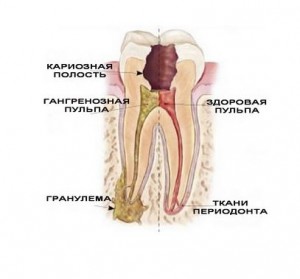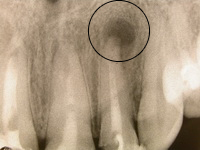Cyst under the crown of the tooth

Cyst of the tooth root under the crown - One of the most dangerous and unpleasant consequences of chronic periodontitis.
The cystic formation is a cavity in the bone, lined from the inside with a dense fibrous membrane.
Inside the cavity is purulent contents.
The danger of the disease is that it is almost impossible to suspect the presence of a cyst in the early stages of the development of the disease, since the patient does not complain.
To detect a disease in this period is possible only on the basis of an x-ray study.
It is for this reason that most patients seek medical help at a late stage of the development of the disease, when severe pain appears and the general condition worsens.
Causes
The emergence of the disease can contribute to the causes, which can be divided as follows: infectious, drug and traumatic.
- The appearance of a cyst under the crown of the tooth occurs most often precisely because of the penetration of the infection under the crown. In case of unsuccessful fitting of the crown to the gum during its fixation, food residues are delayed between the crown and gum, the decomposition of which contributes to the favorable development of pathogenic microorganisms. As a result of their vital activity, a root cyst is formed.
- Sometimes the dentist can poorly fill the root canals and bring in an infection.
- Getting into the unsealed cavity of bacteria that are formed during the decomposition of food particles, which can get under the prosthesis if its fixation is of poor quality.
Symptoms
Cyst under the crown of the tooth manifested by the following complaints:
- Periodic swelling of the gums in the affected tooth.
- Aching pain with pressure on the tooth.
As the disease develops, they join:
- Strong pain.
- Fever.
- The general condition of the patient is deteriorating.
- There is an increase in lymph nodes.
- The formation of flux or fistula.
Treatment
After the dentist has made the final diagnosis, depending on the neglect of the process, the treatment can be conservative or surgical.
Tooth extraction is carried out only in the most extreme case, when other methods are ineffective.

When choosing a method of treatment, the dentist is guided by the examination, X-ray data, computed tomography, if necessary.
- In the early stages of the disease, cysts can be treated without removing the crown.
- For a more effective treatment, the crown is best removed. After removing the prosthesis, the root canals of the tooth are expanded and treated with antibiotics that destroy the cyst. Then the cavity of the cyst is filled with special dental paste, restoring damaged tissue.If the treatment result is successful, a new crown is installed.
- In the absence of the effect of treatment, they resort to surgical intervention. In the presence of obstruction of the root canals, as well as large sizes of the cyst, a microsurgical operation can be performed aimed at removing the cyst and preserving the tooth.
- When a patient seeks medical help in the later stages of the disease, often the only method of treatment is tooth extraction.
Difficulties that may arise during the treatment:
- If there is a pin in the root canal, attempts to remove it often result in perforation, a root fracture, and tooth extraction.
- In order to re-seal the channels, it is necessary to seal them first, which takes a sufficient amount of time and effort. Often, during root canal filling, root perforation takes place.
- After the canals are broken, anti-inflammatory treatment of the focus of inflammation is performed. The duration of treatment is at least two to three months.
- Only after the inflammatory process has subsided, can we again begin to fill the root canals. Moreover, it is necessary to fill it well and to the top of the root. And only after that cover the tooth with a new crown.
- When the cause of inflammation is a poorly sealed apex of the root canal, the surgeon can perform an operation to resect the apical part of the root. In this case, through the small hole drilled in the bone tissue, the top of the root is cut off and the purulent sac is removed.